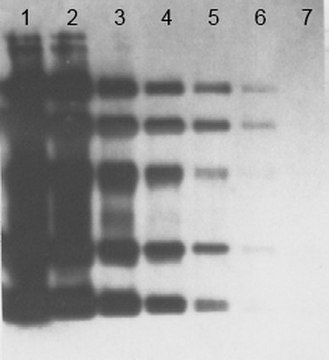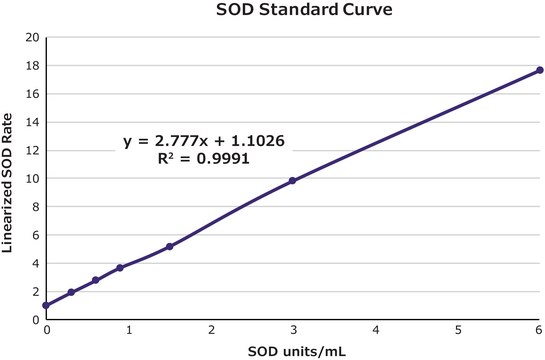Recommended Products
technique(s)
immunocytochemistry: suitable
immunofluorescence: suitable
Quality Level
detection method
fluorometric
General description
Oxidative stress has been found to play a key role in a number of pathological disorders. These affects appear to be mediated by reactive oxygen species (ROS) which cause modifications to proteins, lipids, and DNA. In the case of proteins the ROS primarily cause carbonyl derivatives on amino acid sidechains affecting their enzymatic and biochemical functionality. Not surprisingly, carbonyl formation has become an important biomarker for oxidative stress.
Reactive oxygen species (ROS) have been implicated in pathological processes including cancer, apoptosis, aging, neurodegenerative diseases, chronic inflammatory diseases, pulmonary diseases, and cardiovascular diseases (for reviews, see ref. 1-4).
Living organisms are continually exposed to potentially harmful oxygen free radicals that are generated thru normal cellular functions as well as from environmental factors (1, 5-7). Yet, these reactive molecules are mitigated by the presence of antioxidants and therefore organisms exist with a delicate balance between oxidants and antioxidants (7-9). During times of oxidative stress there is an imbalance in favor of the oxidants. The end result of which is that free radicals are able to attack and modify subcellular components including nucleic acids, lipids and proteins (7, 10-12). In some cases, cells respond to the oxidative stimuli and allow the organism to adapt to the oxidative stress (13-15).
Proteins are one of the major targets of oxygen free radicals and other reactive species
Oxidation of proteins modifies the side chains of methionine, histidine, and tyrosine and forms cysteine disulfide bonds (16-19). Metal catalyzed oxidation of proteins introduces carbonyl groups (aldehydes and ketones) at lysine, arginine, proline or threonine residues in a site-specific manner (16, 20-22). The oxidative modification of proteins can modulate biochemical characteristics of proteins such as enzymatic activity (21-23), DNA binding activities of transcription factors (24-26), and the susceptibility to proteolytic degradation (12, 25-28). While a relationship between protein oxidation and aging has been suggested (29-31), little is known about the importance of oxidative modification of individual proteins in the pathophysiology of free radical mediated processes.
Not surprisingly, carbonyl modification of proteins has become a key biomarker for the identification of oxidative stress. To assist in these research efforts Millipore now offers the OxyICC kit which contains the chemical and immunological reagents necessary to detect the carbonyl groups using fluorescent immunocytochemistry. The test method involves chemical derivatization of protein carbonyl groups with 2,4-dinitrophenylhydrazine (DNPH). This chemical reaction results in proteins being covalently coupled to DNP at their carbonyl sites. The DNP-derivatized proteins are then detected using biotinylated antibodies that are specifically reactive for the DNP moiety. Subsequent incubation with fluorescently conjugated streptavidin enables detection using fluorescence microscopy. The amount of fluorescence detected is correlated to the extent of oxidative stress that the cell was subjected to.
Not surprisingly, carbonyl modification of proteins has become a key biomarker for the identification of oxidative stress. To assist in these research efforts Millipore now offers the OxyICC kit which contains the chemical and immunological reagents necessary to detect the carbonyl groups using fluorescent immunocytochemistry. The test method involves chemical derivatization of protein carbonyl groups with 2,4-dinitrophenylhydrazine (DNPH). This chemical reaction results in proteins being covalently coupled to DNP at their carbonyl sites. The DNP-derivatized proteins are then detected using biotinylated antibodies that are specifically reactive for the DNP moiety. Subsequent incubation with fluorescently conjugated streptavidin enables detection using fluorescence microscopy. The amount of fluorescence detected is correlated to the extent of oxidative stress that the cell was subjected to.
The OxyICC kit provides reagents for immunodetection of protein carbonyls by fluorescent immunocytochemistry. The assay procedure is simple and the results obtained are highly sensitive and quantitative.
Application
Peroxide stressed cell protocol:
- Plate cells normal density (typically add ~30k per well of an 8 well chamber slide).
- Incubate overnight
- Remove media
- Add fresh media containing H2O2 (500uM treatment for 30 minutes or 50uM treatment overnight)
- After appropriate incubation wash cells gently 2X with PBS
- Fix cells with ice cold methanol
- Continue with the OxyICC protocol.
- Plate cells normal density (typically add ~30k per well of an 8 well chamber slide).
- Incubate overnight
- Remove media
- Add fresh media containing H2O2 (500uM treatment for 30 minutes or 50uM treatment overnight)
- After appropriate incubation wash cells gently 2X with PBS
- Fix cells with ice cold methanol
- Continue with the OxyICC protocol.
Components
S7350-1 (Store at 2-8ºC) Streptavidin-Cy3™: (Part No. CS203022) 15µL solution. 2,4-Dinitrophenylhydrazine Solution: (Part No. CS201876) One vial with 1.1mL. 10x PBS Wash Buffer: (Part No. CS201873) One 130mL bottle. 5x Blocking Buffer: (Part No. CS203024) One 10mL bottle. Millex® GP Filter Units (0.22µm): (Part No. SLGP033RB) 3 filters. S7350-2 (Store at - 20ºC) Anti-DNP, Biotinylated (mouse monoclonal) Antibody: (Part No. CS203021) 15µL of a 1mg/mL solution. DAPI: (Part No. CS202687) 10 L of 1mg/mL solution.
Storage and Stability
Dual® Temperature Storage (See Manual for details) Store for up to 6 months after date of receipt.
Legal Information
Cy3 is a trademark of Cytiva
Dual is a registered trademark of Ciba-Geigy AG
Millex is a registered trademark of Merck KGaA, Darmstadt, Germany
Disclaimer
Unless otherwise stated in our catalog or other company documentation accompanying the product(s), our products are intended for research use only and are not to be used for any other purpose, which includes but is not limited to, unauthorized commercial uses, in vitro diagnostic uses, ex vivo or in vivo therapeutic uses or any type of consumption or application to humans or animals.
Regulatory Information
新产品
Certificates of Analysis (COA)
Search for Certificates of Analysis (COA) by entering the products Lot/Batch Number. Lot and Batch Numbers can be found on a product’s label following the words ‘Lot’ or ‘Batch’.
Already Own This Product?
Find documentation for the products that you have recently purchased in the Document Library.
Our team of scientists has experience in all areas of research including Life Science, Material Science, Chemical Synthesis, Chromatography, Analytical and many others.
Contact Technical Service


